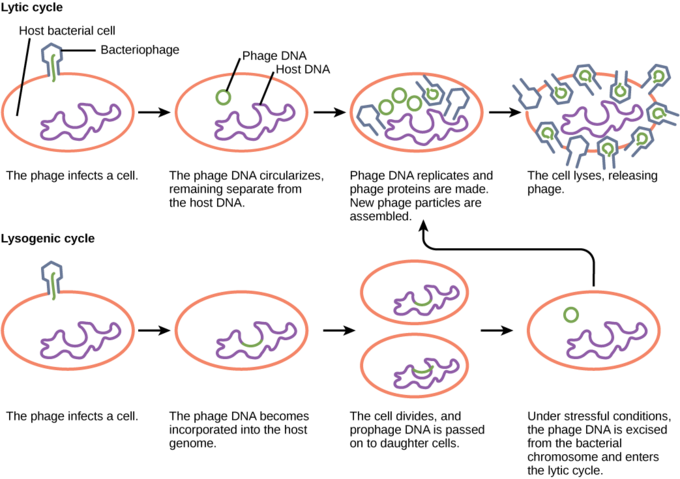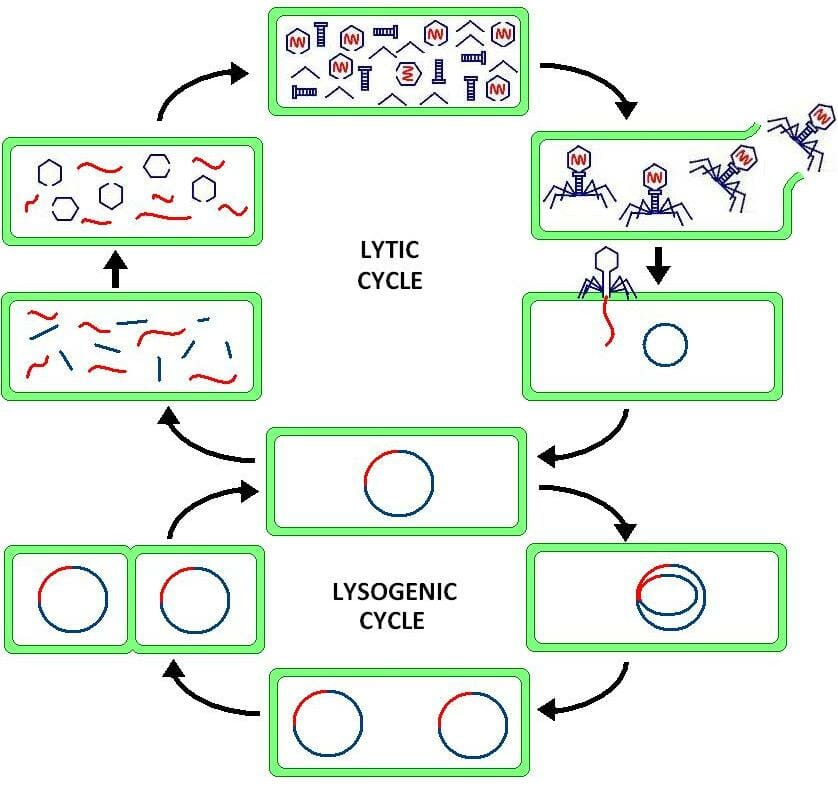Which of the Following Is Characteristic of the Lytic Cycle
Which of the following characteristics is typical of the lytic cycle of a bacteriophage. Many bacterial cells containing viral DNA are produced.

Lysogenic Cycle An Overview Sciencedirect Topics
D A large number of phages is released at a time.

. The viral genome replicates without destroying the host. E The virus-host relationship usually lasts for generations. A Viral DNA is incorporated into the host genome B The viral genome replicates without destroying the host C A large number of phages are released at a time.
The lytic cycle is a type of viral reproduction cycle. Correct Response b A large number of phages are released at a time. B The viral genome replicates without destroying the host.
Thus option d is correct answer. Which of the following is characteristic of the lytic cycle. A Viral DNA incorporates into the host genome.
C The viral genome replicates without destroying the host. B The viral genome replicates without destroying the host. In the lytic cycle the viral DNA deoxyribonucleic acid is incorporated in the host genome.
The virus-host relationship usually lasts for. 15 of 20 IncorrectX earning Match each of the following characteristics to the lytic cycle lysogenic cycle or both Lytic Lysogenic Both the bacterial cell wallincorporated into the b the phage genome is is broken openincorporated into the bacterial chromosome the host DNA is degraded the pha me enters the phage genome replicates. A Viral DNA is incorporated into the host genome.
E The virus-host relationship usually lasts for generations. The correct answer is option D. A Viral DNA is incorporated into the host genome.
D The host sequesters viral particles in the lysosome. The host genome is degraded after which there is a process of assembly where new genome are taken up by the phage particles. D A large number of phages is released at a time.
D Many bacterial cells containing viral DNA are produced. Advertisement Survey Did this page answer your question. Disruption of host cell releases phage molecules.
Since most of the components are proteins they have formed over evolutionary time to be able to come together with very little outside influence. Which of the following is characteristic of the lytic cycle. A Many bacterial cells containing viral DNA are produced.
Question 8 2 points Which of the following is characteristic of the lytic cycle of a bacteriophage. Which of the following is characteristic of the lytic cycle. The viral genome replicates without destroying the host.
A large number of phages are released at a time. 15 of 20 IncorrectX earning Match each of the following characteristics to the lytic cycle lysogenic cycle or both Lytic Lysogenic Both the bacterial cell wallincorporated into the b the phage genome is is broken openincorporated into the bacterial chromosome the host DNA is degraded the pha me enters. Which of the following is characteristic of the lytic cycle.
Which of the following characteristics is typical of the lytic cycle of a bacteriophage. Viral DNA is incorporated into the host genome. Oc A large number of phages are released at a time.
Which of the following characteristics is typical of the lytic cycle of a bacteriophage. Does the variola virus go through the lytic or lysogenic cycle or. B The viral genome replicates without destroying the host.
Which of the following is characteristic of the lytic cycle. B Viral DNA is incorporated into the host genome. Viral DNA is incorporated into the host genome.
Many bacterial cells containing viral DNA are produced. The lytic cycle is a type of viral reproduction cycle. A Many bacterial cells containing viral DNA are produced.
Not at all Slightly. The assembly of new virions is a hallmark of the lytic cycle. D The virushost relationship usually lasts for generations.
The lytic cycle is a cycle of viral reproduction and is how some diseases are spread. Which of the following is characteristic of the lytic cycle. It infects the new host cells.
Many bacterial cells containing viral DNA are produced. 41 Which of the following characteristics is typical of the lytic cycle of a bacteriophage. 8 Which of the following is characteristic of the lytic cycle.
The viral genome replicates without destroying the host. The correct answer is option D. D A large number of phages is released at a time.
5 Which of the following is characteristic of the lytic cycle. D A large number of phages is released at a time. New phages are produced and released while killing the host.
C A large number of phages are released at a time. Which of the following is characteristic of the lytic cycle. D A large number of phages are released at a time.
C A large number of phages are released at a time. C The viral genome replicates without destroying the host. A Many bacterial cells containing viral DNA are produced.
100 56 ratings Transcribed image text. Choose all that apply a the viral genome replicates without destroying the host b the virus-host relationship usually lasts for generations c a large number of phages are released at a time d host cells are destroyed when phages are released. The virus-host relationship usually lasts for generations.
B Viral DNA is incorporated into the host genome. Viral DNA is incorporated into the host genome. C The host membrane ruptures releasing many phages.
New phages are produced and released while killing the host. In this way the lytic cycle resembles a small virus factory. A Viral DNA is incorporated into the host genome.
Lytic cycle is the reproductive cycle of bacteriophage or bacterial viruses. The other viral life cycle does not include producing and assembling new virions. Which of the following statements correctly describes one characteristic of the lytic cycle of viral replication.
This results in the destruction of the infected cell and its membrane. D The virus-host relationship usually lasts for generations. The bacteriphages that replicate via lytic cycle are called as virulent phages and i n the lytic cycle large number of virusphages are released at a time.
Ob The viral genome replicates without destroying the host. C The viral genome replicates without destroying the host. This results in the destruction of the infected cell and its membrane.
View the full answer. Bacteriophage DNA that have become integrated into the host cell chromosome are called. The virus-host relationship usually lasts for generations.

Lytic Vs Lysogenic Understanding Bacteriophage Life Cycles Technology Networks

Lytic Vs Lysogenic Understanding Bacteriophage Life Cycles Technology Networks

Whittaker S System Of Classification Five Kingdom System Of Classification Teaching Biology Kingdom Fungi General Biology

Mitochondria And Chloroplasts Worksheet Pdf Download Mitochondria Chemical Energy Worksheets

The Viral Life Cycle Microbiology

Induced Fit Model Of Enzyme Action Enzymes Active Site Chemical Changes

Virus Infections And Hosts Boundless Biology

Fibrous Dysplasia Varus Deformity Nursing School Ortho

Lytic Vs Lysogenic Understanding Bacteriophage Life Cycles Technology Networks

The Structure Of Endoplasmic Reticulum Rough And Smooth Er Diagram Cell Membrane Structure And Function Things Under A Microscope

Definition Of Mass Number With Examples Isoptopes Mass Number Definition Of Mass Atomic Mass Unit

Lysogenic Cycle An Overview Sciencedirect Topics

Mitochondria Structure And Function With Diagram Mitochondria Structure And Function Oxidative Phosphorylation

Lytic Cycle Definition Steps And Quiz Biology Dictionary

Chromosomal Genetics Youtube Bozeman Science Module 8 14 22 Apologia Biology Secondary Science Biology Resources



Comments
Post a Comment